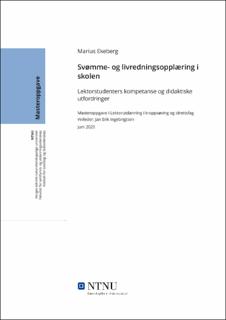| dc.contributor.advisor | Ingebrigtsen, Jan Erik | |
| dc.contributor.author | Ekeberg, Marius | |
| dc.date.accessioned | 2021-09-28T17:31:13Z | |
| dc.date.available | 2021-09-28T17:31:13Z | |
| dc.date.issued | 2020 | |
| dc.identifier | no.ntnu:inspera:54524168:9907943 | |
| dc.identifier.uri | https://hdl.handle.net/11250/2784476 | |
| dc.description.abstract | I 2015 ble kompetansemålene knyttet til svømming- og livredning i skolen endret, hvor det å være svømmedyktig ble konkretisert i kompetansemålene, og det ble lagt større vekt på livberging og førstehjelp tilknyttet vann (Utdanningsdirektoratet, 2015c). I læreplanene som trer i kraft fra 2020 skal målet med undervisningen også være at elevene skal kunne utføre livberging ved vann ute i naturen (Utdanningsdirektoratet, 2020). Dette stiller tydelige krav til kommende kroppsøvingslektorer som skal undervise om dette. På bakgrunn av dette har denne oppgaven belyst følgende problemstilling: Hvordan påvirker studentenes kompetanse deres vurdering av didaktiske utfordringer i svømme- og livredningsopplæring i skolen?
Kroppsøving er et fag i norsk skole hvor lærerne har lite formell kompetanse, og erfaringer fra norsk skole viser at skoleeiere ønsker at lærerne ved deres skole gjerne skulle hatt bedre kompetanse innen svømmeopplæringen (Perlic, 2019; Waagene, Vaagland, Larsen & Frederici, 2018). Kompetanse i denne oppgaven ble tolket og forankret i virksomhetsteori, og særlig Vygotskys bidrag til teorien (Vygotsky, 1978). Didaktiske utfordringer ble sett i lys av en didaktisk relasjonsmodell etter Bjørndal og Lieberg (1978) sin opprinnelige modell, med ulike didaktiske kategorier. Oppgaven har hatt en kvalitativ utforming, og datainnsamlingen bestod av semistrukturerte intervju av 13 lektorstudenter ved kroppsøving og idrettsfag, som dannet grunnlaget for en tematisk analyse.
Resultatene viser at studentene har ulike erfaringer med svømming og livredning i egen skolegang og fra egen fritid. De aller fleste hadde ingen livredningsopplæring på ungdomsskole eller videregående opplæring. Oppfatningen hos studentene, uavhengig av bakgrunn og utdanning, var at svømme- og livredningsopplæringen medførte betydelige utfordringer knyttet til rammefaktorer, elevforutsetninger, innhold og læringsaktiviteter. Studentene med mye svømme- og livredningserfaring hadde større læringsutbytte av utdanningen, og rapporterte at de var mer trygge på å undervise om temaet. Disse opplevde mindre didaktiske utfordringer med undervisningen, og var i større grad bevisst på å gjennomføre opplæringen ute i naturen. Motsatt opplevde studentene med lite svømme- og livredningserfaring seg mindre kompetente, og fikk mindre læringsutbytte av utdanningen. Disse opplevde større didaktiske utfordringer i opplæringen. Forskjellene i læringsutbytte hos studentene forklares ut ifra ulikheter i deres virksomhet som medførte forskjellig proksimalt utviklingsnivå i svømme- og livredningsopplæringen. Studentene i tidligere årstrinn rapporterte mer didaktiske utfordringer, og var mindre bevisste på læringsmålene knyttet til svømme- og livredningsopplæringen. Dette knyttes til mindre fagdidaktisk og pedagogisk utdannelse.
Nøkkelord: svømmeopplæring, livredningsopplæring, undervisning, kompetanse, lektorstudenter, læreplan, didaktiske utfordringer, virksomhetsteori, utdanning | |
| dc.description.abstract | In 2015, the competence aims related to swimming and lifesaving in the Norwegian school curriculum were changed, where being able to swim was specified in the competence aims, and greater emphasis was placed on life saving and first aid (Utdanningsdirektoratet, 2015c). In the new school curriculum that will take effect from 2020, the competence aims also state that the pupils should be able to carry out lifesaving in and around waters outdoors (Utdanningsdirektoratet, 2020). These aims put clear demands on the competence of upcoming physical education (PE) teachers. On this basis, this thesis has investigated the following research question: «How does PE teacher student’s competence affect their assessment of didactic challenges in teaching swimming and lifesaving in school?»
PE is a subject in Norwegian schools where teachers have little formal competence, and many school owners in Norway have reported that they wished teachers at their school had more competence in regards to swimming education (Perlic, 2019; Waagene, Vaagland, Larsen & Frederici, 2018). Competence in this thesis was interpreted and grounded in activity theory, and in particular Vygotsky's contribution to the theory (Vygotsky, 1978). Didactic challenges were interpreted in light of a didactic relationship model based on Bjørndal and Lieberg's (1978) original model, which included different didactic categories. The thesis had a qualitative design, and the collection of data consisted of semi-structured interviews of 13 teacher students in physical education and sports, which formed the basis for a thematic analysis.
The results show that the students have different experiences with swimming and lifesaving in their own schooling and their own leisure. The vast majority had no lifesaving education in neither lower nor upper secondary education. Swimming and lifesaving education posed significant challenges according to the students, regardless of their background and education. These were related to setting, differences in the pupil’s prerequisites for learning, and the activities and contents of the teaching. The students with a lot of prior swimming and lifesaving experience had greater learning benefits from the education and reported that they were more confident in teaching about the topic. They reported less didactic challenges and were to a greater extent aware of the importance of teaching swimming and lifesaving outdoors. Conversely, students with little prior swimming and lifesaving experience felt less competent and received less learning benefit from their education. They also reported greater didactic challenges. The differences in student learning outcomes are explained by differences in their activity that led to different proximal developmental levels in swimming and lifesaving education. Students in earlier years reported more didactic challenges and were less aware of the competence aims associated with swimming and lifesaving education. This was linked to less formal didactic and pedagogical education.
Keywords: swimming, lifesaving, teaching, competence, teachers, teacher students, didactic challenges, curriculum, activity theory, education | |
| dc.language | nob | |
| dc.publisher | NTNU | |
| dc.title | Svømme- og livredningsopplæring i skolen | |
| dc.type | Master thesis | |
